driver seat adjustment Seat Altea XL 2007 Owner's Manual
[x] Cancel search | Manufacturer: SEAT, Model Year: 2007, Model line: Altea XL, Model: Seat Altea XL 2007Pages: 298, PDF Size: 8.87 MB
Page 8 of 298
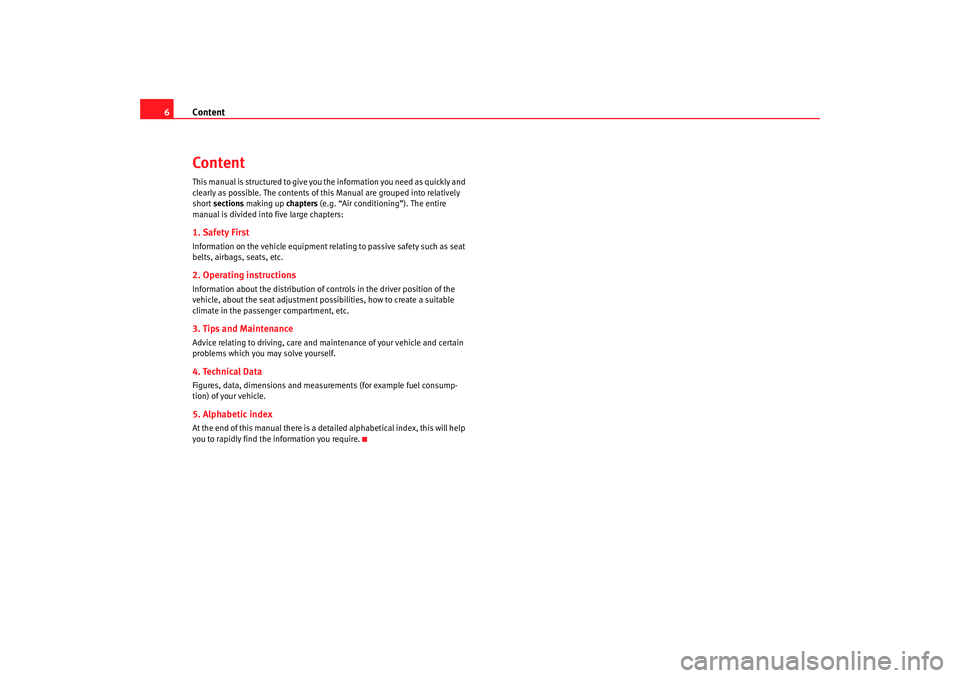
Content
6ContentThis manual is structured to give you the information you need as quickly and
clearly as possible. The contents of t his Manual are grouped into relatively
short sections making up chapters (e.g. “Air conditioning”). The entire
manual is divided into five large chapters:1. Safety FirstInformation on the vehicle equipment relating to passive safety such as seat
belts, airbags, seats, etc.2. Operating instructionsInformation about the distribution of co ntrols in the driver position of the
vehicle, about the seat adjustment possibilities, how to create a suitable
climate in the passenger compartment, etc.3. Tips and MaintenanceAdvice relating to driving, care and ma intenance of your vehicle and certain
problems which you may solve yourself.4. Technical DataFigures, data, dimensions and measurements (for example fuel consump-
tion) of your vehicle.5. Alphabetic indexAt the end of this manual there is a detailed alphabetical index, this will help
you to rapidly find the information you require.
AlteaXL_DEF_ingles Seite 6 Freitag, 25. August 2006 2:19 14
Page 9 of 298
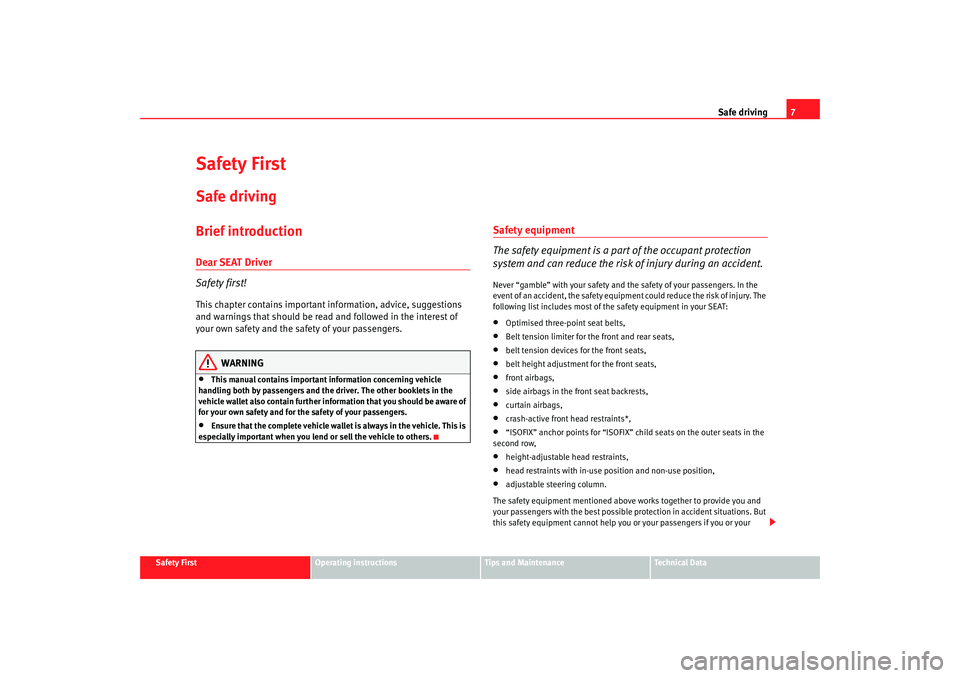
Safe driving7
Safety First
Operating instructions
Tips and Maintenance
Te c h n i c a l D a t a
Safety FirstSafe drivingBrief introductionDear SEAT Driver
Safety first!This chapter contains important information, advice, suggestions
and warnings that should be read and followed in the interest of
your own safety and the safety of your passengers.
WARNING
•
This manual contains important information concerning vehicle
handling both by passengers and the driver. The other booklets in the
vehicle wallet also contain further info rmation that you should be aware of
for your own safety and for the safety of your passengers.
•
Ensure that the complete vehicle wallet is always in the vehicle. This is
especially important when you lend or sell the vehicle to others.
Safety equipment
The safety equipment is a part of the occupant protection
system and can reduce the risk of injury during an accident.Never “gamble” with your safety and the safety of your passengers. In the
event of an accident, the safety equipment could reduce the risk of injury. The
following list includes most of the safety equipment in your SEAT:•
Optimised three-point seat belts,
•
Belt tension limiter for the front and rear seats,
•
belt tension devices for the front seats,
•
belt height adjustment for the front seats,
•
front airbags,
•
side airbags in the front seat backrests,
•
curtain airbags,
•
crash-active front head restraints*,
•
“ISOFIX” anchor points for “ISOFIX” child seats on the outer seats in the
second row,
•
height-adjustable head restraints,
•
head restraints with in-use position and non-use position,
•
adjustable steering column.
The safety equipment mentioned above works together to provide you and
your passengers with the best possible protection in accident situations. But
this safety equipment cannot help you or your passengers if you or your
AlteaXL_DEF_ingles Seite 7 Freitag, 25. August 2006 2:19 14
Page 12 of 298
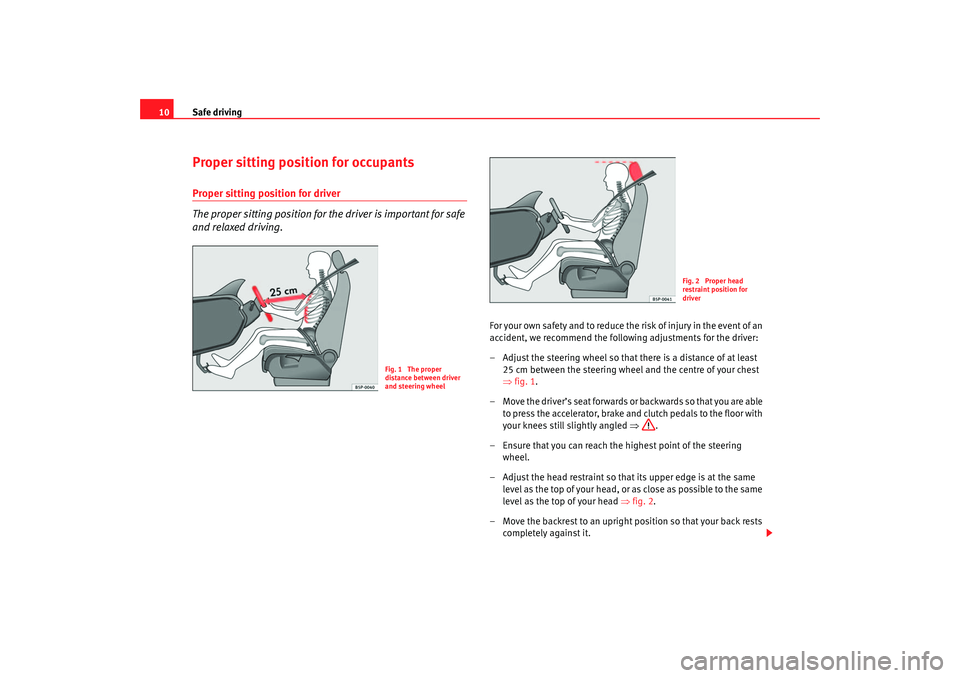
Safe driving
10Proper sitting position for occupantsProper sitting position for driver
The proper sitting position for the driver is important for safe
and relaxed driving.
For your own safety and to reduce the risk of injur y in the event of an
accident, we recommend the following adjustments for the driver:
– Adjust the steering wheel so that there is a distance of at least
25 cm between the steering wheel and the centre of your chest
⇒fig. 1.
– Move the driver’s seat forwards or backwards so that you are able to press the accelerator, brake and clutch pedals to the floor with
your knees still slightly angled ⇒.
– Ensure that you can reach the highest point of the steering wheel.
– Adjust the head restraint so that its upper edge is at the same level as the top of your head, or as close as possible to the same
level as the top of your head ⇒fig. 2.
– Move the backrest to an upright position so that your back rests completely against it.
Fig. 1 The proper
distance between driver
and steering wheel
Fig. 2 Proper head
restraint position for
driver
AlteaXL_DEF_ingles Seite 10 Freitag, 25. August 2006 2:19 14
Page 13 of 298
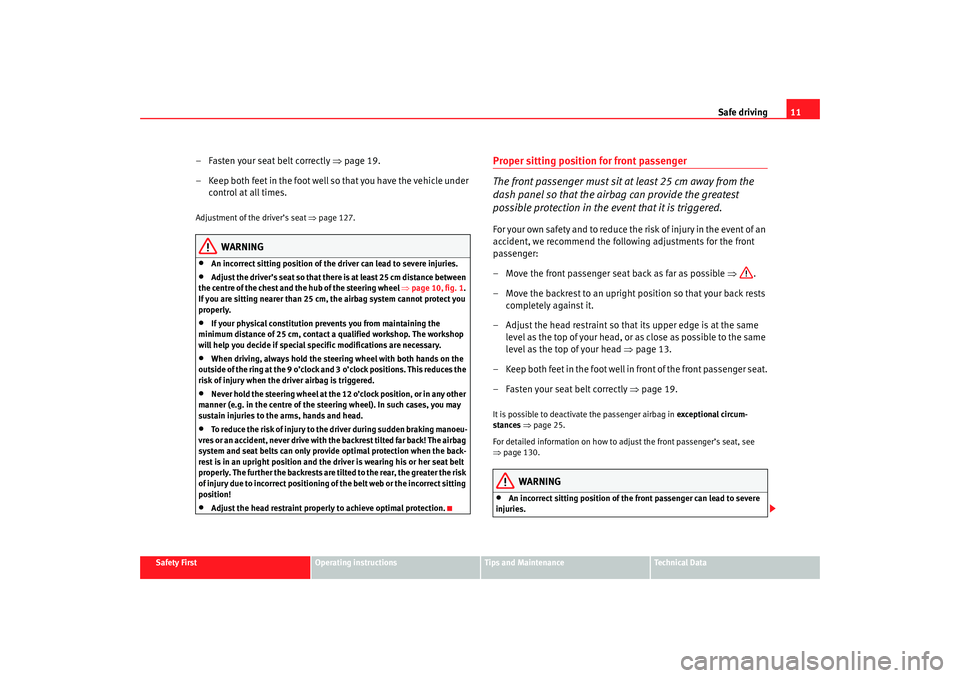
Safe driving11
Safety First
Operating instructions
Tips and Maintenance
Te c h n i c a l D a t a
–Fasten your seat belt correctly ⇒page 19.
– Keep both feet in the foot well so that you have the vehicle under control at all times.Adjustment of the driver’s seat ⇒page 127.
WARNING
•
An incorrect sitting position of the driver can lead to severe injuries.
•
Adjust the driver’s seat so that there is at least 25 cm distance between
the centre of the chest and the hub of the steering wheel ⇒page 10, fig. 1 .
If you are sitting nearer than 25 cm, the airbag system cannot protect you
properly.
•
If your physical constitution prevents you from maintaining the
minimum distance of 25 cm, contact a qualified workshop. The workshop
will help you decide if special specific modifications are necessary.
•
When driving, always hold the steering wheel with both hands on the
outside of the ring at the 9 o’clock and 3 o’clock positions. This reduces the
risk of injury when the driver airbag is triggered.
•
Never hold the steering wheel at the 12 o’clock position, or in any other
manner (e.g. in the centre of the steering wheel). In such cases, you may
sustain injuries to the arms, hands and head.
•
To reduce the risk of injury to the driver during sudden braking manoeu-
vres or an accident, never drive with the backrest tilted far back! The airbag
system and seat belts can only provide optimal protection when the back-
rest is in an upright position and the driver is wearing his or her seat belt
properly. The further the backrests are ti lted to the rear, the greater the risk
of injury due to incorrect positioning of the belt web or the incorrect sitting
position!
•
Adjust the head restraint properly to achieve optimal protection.
Proper sitting position for front passenger
The front passenger must sit at least 25 cm away from the
dash panel so that the airbag can provide the greatest
possible protection in the event that it is triggered.For your own safety and to reduce the risk of injury in the event of an
accident, we recommend the following adjustments for the front
passenger:
– Move the front passenger seat back as far as possible ⇒ .
– Move the backrest to an upright position so that your back rests completely against it.
– Adjust the head restraint so that its upper edge is at the same level as the top of your head, or as close as possible to the same
level as the top of your head ⇒page 13.
– Keep both feet in the foot well in front of the front passenger seat.
– Fasten your seat belt correctly ⇒page 19.It is possible to deactivate the passenger airbag in exceptional circum-
stances ⇒ page 25.
For detailed information on how to adjust the front passenger’s seat, see
⇒ page 130.
WARNING
•
An incorrect sitting position of the front passenger can lead to severe
injuries.
AlteaXL_DEF_ingles Seite 11 Freitag, 25. August 2006 2:19 14
Page 17 of 298
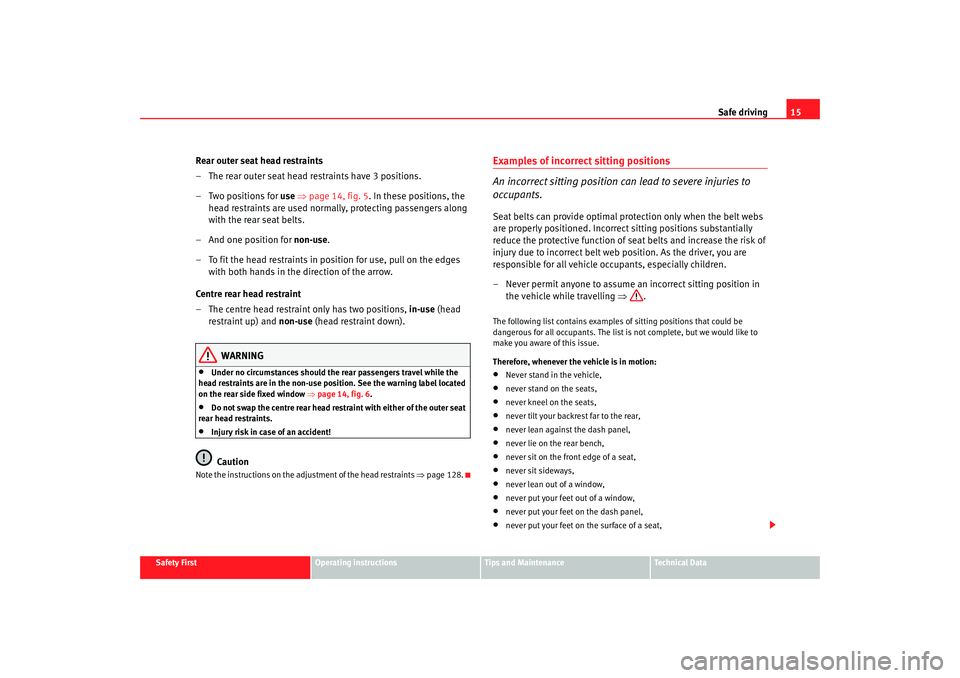
Safe driving15
Safety First
Operating instructions
Tips and Maintenance
Te c h n i c a l D a t a
Rear outer seat head restraints
– The rear outer seat head restraints have 3 positions.
–Two positions for use ⇒ page 14, fig. 5 . In these positions, the
head restraints are used normally, protecting passengers along
with the rear seat belts.
– And one position for non-use.
– To fit the head restraints in posi tion for use, pull on the edges
with both hands in the direction of the arrow.
Centre rear head restraint
– The centre head restraint only has two positions, in-use (head
restraint up) and non-use (head restraint down).
WARNING
•
Under no circumstances should the rear passengers travel while the
head restraints are in the non-use position. See the warning label located
on the rear side fixed window ⇒page 14, fig. 6 .
•
Do not swap the centre rear head restraint with either of the outer seat
rear head restraints.
•
Injury risk in case of an accident!Caution
Note the instructions on the adjustment of the head restraints ⇒page 128.
Examples of incorrect sitting positions
An incorrect sitting position can lead to severe injuries to
occupants.Seat belts can provide optimal protection only when the belt webs
are properly positioned. Incorrec t sitting positions substantially
reduce the protective function of se at belts and increase the risk of
injury due to incorrect belt web position. As the driver, you are
responsible for all vehicle occupants, especially children.
– Never permit anyone to assume an incorrect sitting position in the vehicle while travelling ⇒ .The following list contains examples of sitting positions that could be
dangerous for all occupants. The list is not complete, but we would like to
make you aware of this issue.
Therefore, whenever the vehicle is in motion:•
Never stand in the vehicle,
•
never stand on the seats,
•
never kneel on the seats,
•
never tilt your backrest far to the rear,
•
never lean against the dash panel,
•
never lie on the rear bench,
•
never sit on the front edge of a seat,
•
never sit sideways,
•
never lean out of a window,
•
never put your feet out of a window,
•
never put your feet on the dash panel,
•
never put your feet on the surface of a seat,
AlteaXL_DEF_ingles Seite 15 Freitag, 25. August 2006 2:19 14
Page 49 of 298

Child safety47
Safety First
Operating instructions
Tips and Maintenance
Te c h n i c a l D a t a
Safety notes on using child seats
Proper use of child seats substantially reduces the risk of
injury in an accident!As the driver, you are responsible for any children you transport in
your vehicle.
– Protect your children by properly using appropriate child seats
⇒page 48.
– Always ensure that the belt webbing is properly positioned according to the instructions prov ided by the manufacturer of the
child seat.
– When travelling, do not allow children to distract you from traffic.
– Take breaks regularly during long trips. Take a break at least every two hours.
WARNING
•
Never install a child seat facing backwards (or rear-facing) on the front
passenger seat unless the front passenger airbag has been disabled. This
represents a risk of fatal injuries to the child! However, if it is necessary, in
exceptional cases, to transport a child in the front passenger seat, the front
passenger airbag must always be disabled ⇒page 44, “Deactivating
airbags*”. If the passenger seat has a height adjustment option, move it to
the highest position.
•
For those vehicles that do not include a key lock switch to turn the
airbag off, an Authorised Service Centre must be consulted.
•
All passengers, especially children, must assume the proper sitting
position and be properly belted in while travelling.
•
Never hold children or babies on your lap, this can result in potentially
fatal injuries to the child!
•
Never allow a child to be transported in a vehicle without being properly
secured, or to stand up or kneel on a seat while travelling. In an accident,
the child could be flung through the vehicle, causing possibly fatal injuries
to themselves and other occupants.
•
If children assume an improper sitting position when the car is moving,
they expose themselves to greater risk of injury during a sudden braking
manoeuvre or in an accident. This is particularly the case if the child is trav-
elling on the front passenger seat and the airbag system is triggered in an
accident; this could have consequences including serious injury or death.
•
A suitable child seat can protect your child!
•
Never leave a child unsupervised in a child seat or alone in the vehicle.
•
Depending on weather conditions, it may become extremely hot or cold
inside the vehicle. This can be fatal.
•
Children who are less than 1.5 metres tall must not wear a normal seat
belt without a child restraint system, as this could cause injuries to the
abdominal and neck areas during a sudden braking manoeuvre or in an
accident.
•
Do not allow the belt webbing to become twisted or jammed, or to rub
on any sharp edges.
•
Incorrectly worn seat belts can cause injuries even in a minor collision
or sudden braking manoeuvres.
•
The seat belt provides maximum protection only when the belt web is
properly positioned ⇒page 24, “Seat belts”.
•
Only one child may occupy a child seat ⇒page 48, “Child seats”.WARNING (continued)
AlteaXL_DEF_ingles Seite 47 Freitag, 25. August 2006 2:19 14
Page 129 of 298

Seats and stowage127
Safety First
Operating instructions
Tips and Maintenance
Te c h n i c a l D a t a
Seats and stowageThe importance of correct seat adjustmentProper seat adjustment optimi ses the level of protection
offered by seat belts and airbags.Your vehicle has five passenger places, two individual front seats and three
places on the rear seat. Each seat is equipped with a three-point seat belt.
The driver seat and front passenger seat can be adjusted in many ways to suit
the physical requirements of the vehicle occupants. The correct seat position
is very important for:•
fast and easy operation of all controls on the instrument panel,
•
relaxed posture that does not cause drowsiness,
•
safe driving ⇒ page 7,
•
and to ensure that the seat belts and airbag system provide maximum
protection ⇒page 19.
WARNING
•
If the driver and passengers assume improper sitting positions, they
may sustain critical injuries.
•
Never transport more people than there are seats available in the
vehicle.
•
Every occupant in the vehicle must properly fasten and wear the seat
belt belonging to his or her seat. Children must be protected with an appro-
priate child restraint system ⇒page 46, “Child safety”.
•
The front seats and all headrests must always be adjusted to body size
and the seat belt must always be properly adjusted to provide you and your
passengers with optimum protection.
•
Always keep your feet in the foot well when the vehicle is moving; never
rest them on the dash panel, out of the window or on the seat. This also
applies to passengers. An incorrect sitting position exposes you to an
increased risk of injury in the event of a braking manoeuvre or an accident.
If the airbag is triggered, you could sustain severe injuries due to an incor-
rect sitting position.
•
It is important for the driver and front passenger to maintain a distance
of at least 25 cm from the steering wheel or dash panel. Failure to respect
the minimum distance means that the airbag will not protect you. Risk of
fatal injury. The distance between the driver and the steering wheel or
between the front passenger and the dash panel should always be as great
as possible.
•
Adjust the driver or front passenger seat only when the vehicle is
stationary. This also applies to the forwards/backwards adjustment of the
rear seats. Otherwise your seat coul d move unexpectedly while the vehicle
is moving. This could increase the risk of an accident and therefore injury.
In addition, while adjusting your seat, you will assume an incorrect sitting
position. Risk of fatal accidents.
•
Special guidelines apply to installing a child seat on the front
passenger seat. When installing a child seat, observe the warning note in
the ⇒page 46, “Child safety”.WARNING (continued)
AlteaXL_DEF_ingles Seite 127 Freitag, 25. August 2006 2:19 14
Page 132 of 298
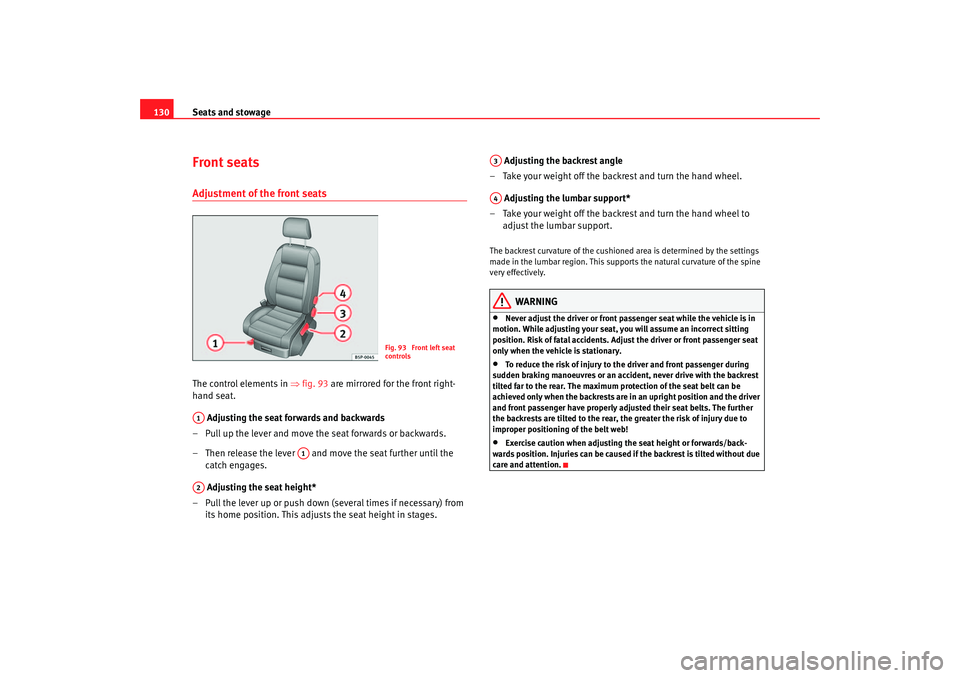
Seats and stowage
130Front seatsAdjustment of the front seatsThe control elements in ⇒fig. 93 are mirrored for the front right-
hand seat.
Adjusting the seat forwards and backwards
– Pull up the lever and move the seat forwards or backwards.
– Then release the lever and move the seat further until the catch engages.
Adjusting the seat height*
– Pull the lever up or push down (s everal times if necessary) from
its home position. This adjusts the seat height in stages. Adjusting the backrest angle
– Take your weight off the backrest and turn the hand wheel.
Adjusting the lumbar support*
– Take your weight off the backrest and turn the hand wheel to adjust the lumbar support.
The backrest curvature of the cushioned area is determined by the settings
made in the lumbar region. This supports the natural curvature of the spine
very effectively.
WARNING
•
Never adjust the driver or front passenger seat while the vehicle is in
motion. While adjusting your seat, you will assume an incorrect sitting
position. Risk of fatal accidents. Adju st the driver or front passenger seat
only when the vehicle is stationary.
•
To reduce the risk of injury to th e driver and front passenger during
sudden braking manoeuvres or an acci dent, never drive with the backrest
tilted far to the rear. The maximum protection of the seat belt can be
achieved only when the backrests are in an upright position and the driver
and front passenger have properly adjusted their seat belts. The further
the backrests are tilted to the rear, the greater the risk of injury due to
improper positioning of the belt web!
•
Exercise caution when adjusting the seat height or forwards/back-
wards position. Injuries can be caused if the backrest is tilted without due
care and attention.
Fig. 93 Front left seat
controls
A1
A1
A2
A3A4
AlteaXL_DEF_ingles Seite 130 Freitag, 25. August 2006 2:19 14
Page 161 of 298

Driving159
Safety First
Operating instructions
Tips and Maintenance
Te c h n i c a l D a t a
DrivingSteeringAdjusting the steering wheel position
The height and reach of the steering wheel can be freely
adjusted to suit the driver.
– Adjust the driver seat to the correct position.
– Push the lever under the steering column ⇒fig. 128 down
⇒ .
– Adjust the steering wheel in this way until the correct position is set ⇒fig. 129 .
– Then push the lever up again firmly ⇒.
WARNING
•
Incorrect use of the steering column adjustment function and an incor-
rect seating position can result in serious injury.
•
To avoid accidents, the steering column should be adjusted only when
the vehicle is stationary. Risk of accident.
Fig. 128 Adjusting the
steering wheel position
Fig. 129 Proper sitting
position for driver
AlteaXL_DEF_ingles Seite 159 Freitag, 25. August 2006 2:19 14
Page 295 of 298
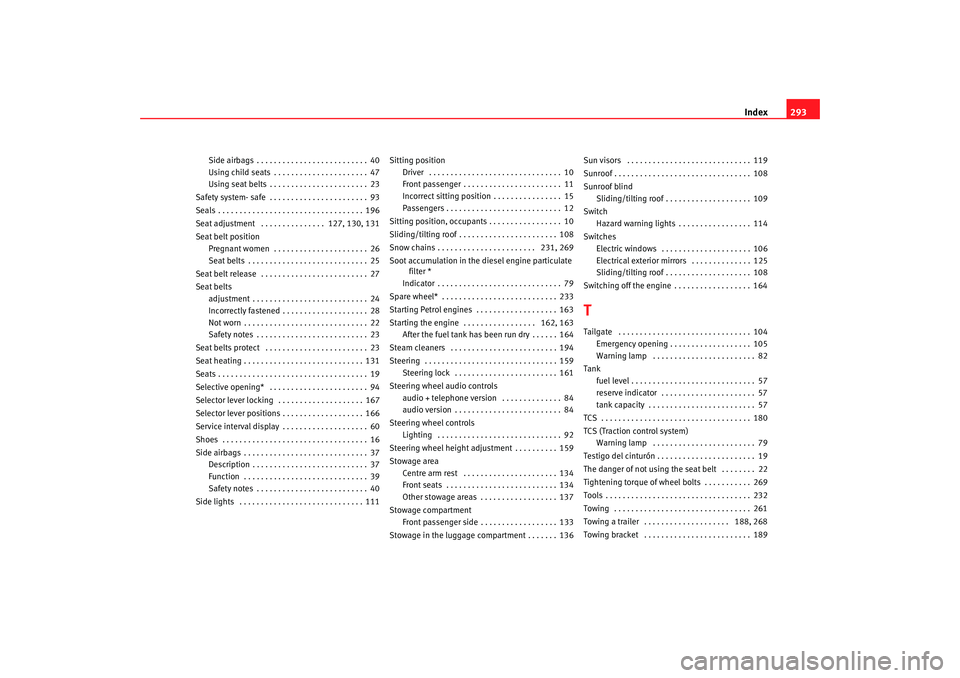
Index293
Side airbags . . . . . . . . . . . . . . . . . . . . . . . . . . 40
Using child seats . . . . . . . . . . . . . . . . . . . . . . 47
Using seat belts . . . . . . . . . . . . . . . . . . . . . . . 23
Safety system- safe . . . . . . . . . . . . . . . . . . . . . . . 93
Seals . . . . . . . . . . . . . . . . . . . . . . . . . . . . . . . . . . 196
Seat adjustment . . . . . . . . . . . . . . . 127, 130, 131
Seat belt position Pregnant women . . . . . . . . . . . . . . . . . . . . . . 26
Seat belts . . . . . . . . . . . . . . . . . . . . . . . . . . . . 25
Seat belt release . . . . . . . . . . . . . . . . . . . . . . . . . 27
Seat belts adjustment . . . . . . . . . . . . . . . . . . . . . . . . . . . 24
Incorrectly fastened . . . . . . . . . . . . . . . . . . . . 28
Not worn . . . . . . . . . . . . . . . . . . . . . . . . . . . . . 22
Safety notes . . . . . . . . . . . . . . . . . . . . . . . . . . 23
Seat belts protect . . . . . . . . . . . . . . . . . . . . . . . . 23
Seat heating . . . . . . . . . . . . . . . . . . . . . . . . . . . . 131
Seats . . . . . . . . . . . . . . . . . . . . . . . . . . . . . . . . . . . 19
Selective opening* . . . . . . . . . . . . . . . . . . . . . . . 94
Selector lever locking . . . . . . . . . . . . . . . . . . . . 167
Selector lever positions . . . . . . . . . . . . . . . . . . . 166
Service interval display . . . . . . . . . . . . . . . . . . . . 60
Shoes . . . . . . . . . . . . . . . . . . . . . . . . . . . . . . . . . . 16
Side airbags . . . . . . . . . . . . . . . . . . . . . . . . . . . . . 37 Description . . . . . . . . . . . . . . . . . . . . . . . . . . . 37
Function . . . . . . . . . . . . . . . . . . . . . . . . . . . . . 39
Safety notes . . . . . . . . . . . . . . . . . . . . . . . . . . 40
Side lights . . . . . . . . . . . . . . . . . . . . . . . . . . . . . 111 Sitting position
Driver . . . . . . . . . . . . . . . . . . . . . . . . . . . . . . . 10
Front passenger . . . . . . . . . . . . . . . . . . . . . . . 11
Incorrect sitting position . . . . . . . . . . . . . . . . 15
Passengers . . . . . . . . . . . . . . . . . . . . . . . . . . . 12
Sitting position, occupants . . . . . . . . . . . . . . . . . 10
Sliding/tilting roof . . . . . . . . . . . . . . . . . . . . . . . 108
Snow chains . . . . . . . . . . . . . . . . . . . . . . . 231, 269
Soot accumulation in the diesel engine particulate
filter *
Indicator . . . . . . . . . . . . . . . . . . . . . . . . . . . . . 79
Spare wheel* . . . . . . . . . . . . . . . . . . . . . . . . . . . 233
Starting Petrol engines . . . . . . . . . . . . . . . . . . . 163
Starting the engine . . . . . . . . . . . . . . . . . 162, 163 After the fuel tank has been run dry . . . . . . 164
Steam cleaners . . . . . . . . . . . . . . . . . . . . . . . . . 194
Steering . . . . . . . . . . . . . . . . . . . . . . . . . . . . . . . 159 Steering lock . . . . . . . . . . . . . . . . . . . . . . . . 161
Steering wheel audio controls audio + telephone version . . . . . . . . . . . . . . 84
audio version . . . . . . . . . . . . . . . . . . . . . . . . . 84
Steering wheel controls Lighting . . . . . . . . . . . . . . . . . . . . . . . . . . . . . 92
Steering wheel height adjustment . . . . . . . . . . 159
Stowage area Centre arm rest . . . . . . . . . . . . . . . . . . . . . . 134
Front seats . . . . . . . . . . . . . . . . . . . . . . . . . . 134
Other stowage areas . . . . . . . . . . . . . . . . . . 137
Stowage compartment Front passenger side . . . . . . . . . . . . . . . . . . 133
Stowage in the luggage compartment . . . . . . . 136 Sun visors . . . . . . . . . . . . . . . . . . . . . . . . . . . . . 119
Sunroof . . . . . . . . . . . . . . . . . . . . . . . . . . . . . . . . 108
Sunroof blind
Sliding/tilting roof . . . . . . . . . . . . . . . . . . . . 109
Switch Hazard warning lights . . . . . . . . . . . . . . . . . 114
Switches Electric windows . . . . . . . . . . . . . . . . . . . . . 106
Electrical exterior mirrors . . . . . . . . . . . . . . 125
Sliding/tilting roof . . . . . . . . . . . . . . . . . . . . 108
Switching off the engine . . . . . . . . . . . . . . . . . . 164
TTailgate . . . . . . . . . . . . . . . . . . . . . . . . . . . . . . . 104 Emergency opening . . . . . . . . . . . . . . . . . . . 105
Warning lamp . . . . . . . . . . . . . . . . . . . . . . . . 82
Tank fuel level . . . . . . . . . . . . . . . . . . . . . . . . . . . . . 57
reserve indicator . . . . . . . . . . . . . . . . . . . . . . 57
tank capacity . . . . . . . . . . . . . . . . . . . . . . . . . 57
TCS . . . . . . . . . . . . . . . . . . . . . . . . . . . . . . . . . . . 180
TCS (Traction control system) Warning lamp . . . . . . . . . . . . . . . . . . . . . . . . 79
Testigo del cinturón . . . . . . . . . . . . . . . . . . . . . . . 19
The danger of not using the seat belt . . . . . . . . 22
Tightening torque of wheel bo lts . . . . . . . . . . . 269
Tools . . . . . . . . . . . . . . . . . . . . . . . . . . . . . . . . . . 232
Towing . . . . . . . . . . . . . . . . . . . . . . . . . . . . . . . . 261
Towing a trailer . . . . . . . . . . . . . . . . . . . . 188, 268
Towing bracket . . . . . . . . . . . . . . . . . . . . . . . . . 189
AlteaXL_DEF_ingles Seite 293 Freitag, 25. August 2006 2:19 14